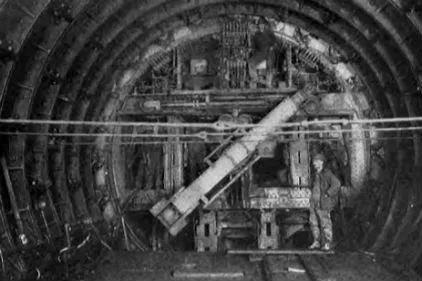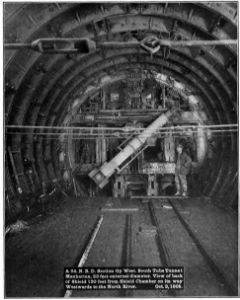Foundation Drilling a Century Ago

The PBS show American Experience recently released "The Rise and Fall of Penn Station." If you get a chance, find the next air time and watch. Penn Station has its own storied history. The show, however, went beyond construction (and eventual demolition) of the famed New York landmark. It also discussed the drilling of tunnels under the East River and Hudson River to allow trains to get to Manhattan in the first place.
It's fascinating stuff, particularly given this all happened just after the turn of the 20th century. Boring a tunnel of this scale challenges foundations engineers in 2014. Just ask the folks trying to get Bertha boring again under Seattle. In 1904, when this started, I can only imagine.
Drillers, blasters, muckers, electricians, pipe fitters and others built tunnels under the East River between Manhattan and Long Island, and under the Hudson River between Manhattan and Weehawken, N.J. According to the show I watched, these tunnels encompassed 7 miles of underground construction.

|
| This image from 1905 shows a view from behind the shield used to bore one of the Hudson River tunnels for the Pennsylvania Railroad. It would eventually connect to Manhattan and Penn Station. Source: Public Domain |
The chief difference between 1904 and 2014? The tunnels to Manhattan were built using tunneling shields advanced from either side of the river (much like earlier projects for London's Underground). The shields were advanced inch by inch as men opened doors in them to excavate material in front. Using this method, and depending on the material in front of them, work crews could move ahead 2-4 feet per day. Donkeys and carts carried the detritus back along the tunnel to the surface.
There were no 6-story cutting heads, like we now see on Bertha and other giant tunnel boring machines. There were no rail cars and conveyors waiting for material from the cutting head.
I think any generation has the tendency to think people of earlier generations were Neanderthals. It’s a fallacy to think the “simpler” in “simpler times” applies to people or what they were capable of. The show mentions that, for one of these tunnels, when the "sandhogs" (as the underground workers were called) met in the middle the two halves of the tunnel were only off by 1/16th of an inch. Think about that. They started from either side of the river, tunneled hundreds of feet through glacial rock and silt, and were only off target by a fraction of an inch. Not bad at all.
The New York Times did an interesting interactive graphic on the difference between modern and early-20th century tunnel boring. You can find it here.
Drilling Under the East River
Conditions under the rivers tested all sandhogs who thought they had the meddle to work in the tunnels. The conditions and plenty of other details of the projects can be found in “The Subways and Tunnels of New York.” The bends was a constant threat. Sandhogs also worked in fear of blowouts, where the soft silt above their heads would give way. Their air would rush out as water from the river rushed in. Several men died of depressurization sickness or drowned during blowouts.
For the privilege of working on a project compared to the Panama Canal in scope, drillers got $4 a day. If it sounds paltry, it is even by today’s standards. This calculator from the Bureau of Labor Statistics only goes back to 1913, so it's off by a few years. But, according to the calculator, four dollars in 1913 equals about $94 today. That’s the equivalent of about $94 per day for 10 hours of work. Shoot, people working fast food in some cities make more than $9.40 an hour these days.
The drillers' helpers made $3 a day and the muckers made $2.75 a day. I don't know what a mucker is, but you can bet it wasn't a cushy job at the equivalent of $6.47 per hour in today’s dollars.
Much better to carry the drill.
It’s American to complain about your job. I do it. You do it. But it could be worse. We could be slinging muck in a tunnel under the East River for six bucks an hour. Kind of puts things in perspective, doesn't it?
Stay safe out there, drillers.
